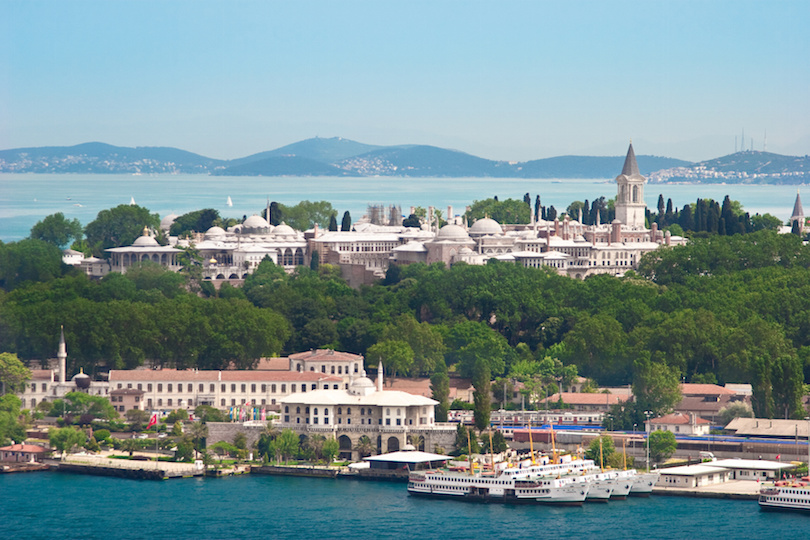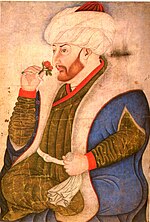
When Sultan Mehmet the Conqueror took Constantinople in 1453, he first ordered the construction of a new residence. This was to become the palace later known as Topkapi. The palace would remain the imperial enclave of the Ottoman sultans for 4 centuries, from 1465 to 1853. Over the years the palace complex underwent constant modifications. Today the complex is made up of four main courtyards of increasing grandeur and many smaller buildings.The Topkapı Palace (Turkish: Topkapı Sarayı[2]or in Ottoman Turkish: طوپقپو سرايى, Ṭopḳapu Sarāyı),[3] or the Seraglio,[4] is a large museum in Istanbul, Turkey. In the 15th century, it served as the main residence and administrative headquarters of the Ottoman sultans.Construction began in 1459, ordered by Mehmed the Conqueror, six years after the conquest of Constantinople. Topkapı was originally called the "New Palace" (Yeni Sarayor Saray-ı Cedîd-i Âmire) to distinguish it from the Old Palace [tr] in Beyazıt Square. It was given the name Topkapı, meaning Cannon Gate, in the 19th century.[5] The complex was expanded over the centuries, with major renovations after the 1509 earthquake and the 1665 fire. The palace complex consists of four main courtyards and many smaller buildings. Female members of the Sultan's family lived in the harem, and leading state officials, including the Grand vizier, held meetings in the Imperial Council building.
After the 17th century, Topkapı gradually lost its importance. The sultans of that period preferred to spend more time in their new palaces along the Bosphorus. In 1856, Sultan Abdulmejid I decided to move the court to the newly built Dolmabahçe Palace. Topkapı retained some of its functions including the imperial treasury, library and mint.Following the end of the Ottoman Empire in 1923, Topkapı was transformed into a museum by a government decree dated April 3, 1924. The Topkapı Palace Museum is administered by the Ministry of Culture and Tourism. The palace complex has hundreds of rooms and chambers, but only the most important are accessible to the public today, including the Ottoman Imperial Harem and the treasury, called hazine where the Spoonmaker's Diamond and Topkapi Dagger are on display. The museum collection also includes Ottoman clothing, weapons, armor, miniatures, religious relics, and illuminated manuscripts like the Topkapi manuscript. The complex is guarded by officials of the ministry as well as armed guards of the Turkish military. Topkapı Palace is part the Historic Areas of Istanbul, a group of sites in Istanbul that were added to the UNESCO World Heritage Site in 1985.[6]
NameEdit

The name of the palace was Saray-i Cedid-i Amire (Ottoman: سراى جديد عامره, Imperial New Palace) until the 18th century.[7] The palace received its current name during Mahmud I's reign; when Topkapusu Sâhil Sarâyı, the seaside palace, was destroyed in a fire its name was transferred to the Palace.[8] In Turkish the current name of the palace, Topkapı, means Cannon Gate.[9][better source needed]
HistoryEdit

Sultan Mehmed II ordered the initial construction around the 1460sThe palace complex is located on the Seraglio Point (Sarayburnu), a promontory overlooking the Golden Horn, where the Bosphorus Straitmeets the Marmara Sea. The terrain is hilly and the palace itself is located at one of the highest points close to the sea. During Greek and Byzantine times, the acropolis of the ancient Greek city of Byzantion stood here.[citation needed]
After Sultan Mehmed II's conquest of Istanbul in 1453, the Great Palace of Constantinoplewas largely in ruins.[10] The Ottoman court was initially set up in the Old Palace (Eski Saray), today the site of Istanbul University in Beyazit Square. Mehmed II ordered that construction of Topkapı Palace begin in 1459. According to an account of the contemporary historian Critobulus of Imbros the sultan "took care to summon the very best workmen from everywhere – masons and stonecutters and carpenters ... For he was constructing great edifices which were to be worth seeing and should in every respect vie with the greatest and best of the past."[11] Accounts differ as to when construction of the inner core of the palace started and was finished. Kritovolous gives the dates 1459–1465; other sources suggest construction was completed in the late 1460s.[12]Mehmed II established the basic layout of the palace. His private quarters would be located at the highest point of the promontory.[13]Various buildings and pavilions surrounded the innermost core and winded down the promontory towards the shores of the Bosphorus.[citation needed] The entire complex was surrounded by high walls, some of which date back to the Byzantine acropolis. This basic layout governed the pattern of future renovations and extensions. The layout and appearance of Topkapı Palace was unique amongst not only European travellers, but also Islamic or oriental palaces. European travellers described it as "irregular, asymmetric, non-axial, and [of] un-monumental proportions". Ottomans called it "The Palace of Felicity".[14] A strict, ceremonial, codified daily life ensured imperial seclusion from the rest of world.[15]One of the central tenets was the observation of silence in the inner courtyards. The principle of imperial seclusion is a tradition that was codified by Mehmed II in 1477 and 1481 in the Kanunname Code, which regulated the rank order of court officials, the administrative hierarchy, and protocol matters.[16] This principle of increased seclusion over time was reflected in the construction style and arrangements of various halls and buildings. The architects had to ensure that even within the palace, the sultan and his family could enjoy a maximum of privacy and discretion, making use of grilled windows and building secret passageways.[17]Later sultans made various modifications to the palace, though Mehmed II's basic layout was mostly preseved. The palace was significantly expanded between 1520 and 1560, during the reign of Suleyman the Magnificent. The Ottoman Empire had expanded rapidly and Suleyman wanted his residence to reflect its growing power. The chief architect in this period was the Persian Alaüddin, also known as Acem Ali.[18] He was also responsible for the expansion of the Harem.[citation needed]
In 1574, after a great fire destroyed the kitchens, Mimar Sinan was entrusted by Sultan Selim II to rebuild the damaged parts of the palace. Mimar Sinan restored and expanded not only the damaged areas, but also the Harem, baths, the Privy Chamber and various shoreline pavilions.[18]

Basketmakers' Kiosk (foreground), Topkapı Palace in the back.By the end of the 16th century, the palace had acquired its present appearance.[citation needed]The palace is an extensive complex rather than a single monolithic structure, with an assortment of low buildings constructed around courtyards, interconnected with galleries and passages. Few of the buildings exceed two stories.[citation needed] Seen from above, the palace grounds are divided into four main courtyards and the harem. The first courtyard was the most accessible, while the fourth courtyard and the harem were the most inaccessible. Access to these courtyards was restricted by high walls and controlled with gates. Apart from the four to five main courtyards, various other small to mid-sized courtyards exist throughout the complex. Estimates of the total size of the complex varies from around 592,600 m2 (146.4 acres)[19] to 700,000 m2 (173 acres).[20]
Security concernsEdit
The palace has been deemed lax on security and preservation by some experts,[65] who point out that the palace has no climate-controlled rooms or storage and is a "security nightmare".[65]
Since many of the walls of the palace are ten feet thick, it mostly escaped structural damage during the 1999 İzmit earthquake. Following this catastrophe, the museum director placed the porcelain collection on more secure mounts in the palace.[65]
During a 1999 robbery, thieves stole portions of a 12th-century Qur'an from a locked exhibit in the library.[65]
On November 30, 2011, Libyan ex-police and revolutionary Samir Salem Ali Elmadhavri, apparently copying the act of Norwegian extremist Anders Behring Breivik, attempted to massacre hundreds of tourists visiting the Palace in the early hours.[90] Stopped at the Bab-i Humayun entrance by the Palace Guards, he opened fire on soldiers and security guards, injuring Private Şerafettin Eray Topçu and security guard Mehmet Ballıcı. After that he entered the main courtyard of the palace but was forced to retreat and search shelter in the entrance by Palace Guard force. After a gunfight lasting over one hour he was killed by Turkish Police SWAT teams. The incident sparked discussions about Palace security, because a foreigner was able to enter the Palace in broad daylight, during working hours, while carrying two hunting rifles. More security measures were put in place at the Palace entrance the day after the incident.
TreesEdit

One of the hollow trees, in the Third CourtThe trees in the Topkapı Palace complex are remarkable, as many have fallen victim to a fungus that has completely hollowed out their trunks, over the course of centuries. The trees nonetheless survive and remain standing. In other cases, two trees of a different kind have grown and fused together, such as a fig treethat grew in the hollow of another tree and effectively grafted with it. This phenomenon can be seen in the second courtyard.
Outer gardensEdit
Surrounding the whole complex of the First to the Fourth Courtyard are the outer palace gardens. A part of this area that is facing the sea is also known as the Fifth Place.
Mehmed II also had three pavilions, or kiosks, constructed, of which only the Tiled Kiosk(Çinili Köşkü) has survived. The Tiled Pavilion dates to around 1473 and houses the Islamic ceramics collection of the Istanbul Archaeology Museums.
Along the shore a number of pavilions were constructed for the sultan's viewing pleasure. These included the Shore Kiosk, Pearl Kiosk, Marble Kiosk and the Basketmakers' Kiosk. Most of the pavilions along with some of the seaside walls and gates were destroyed when the railway lines leading to the Sirkeci railway station were constructed in the late 19th century. The Basketmakers' Kiosk however was saved.
Located next to the First Courtyard towards the city lies the Gülhane Park, the old imperial rose garden, which belonged to the larger complex of the palace. This park is open to the public. Located at the gate to the park is the Procession Kiosk.
To the west and south the complex is bordered by the large imperial flower park, known today as Gülhane Park. Various related buildings such as small summer palaces (kasır), pavilions, kiosks (köşk) and other structures for royal pleasures and functions formerly existed at the shore in an area known as the Fifth Courtyard, but have disappeared over time due to neglect and the construction of the shoreline railroad in the 19th century. The last remaining seashore structure that still exists today is the Basketmakers' Kiosk, constructed in 1592 by Sultan Murad III.[citation nee6ded]
Comments
Post a Comment